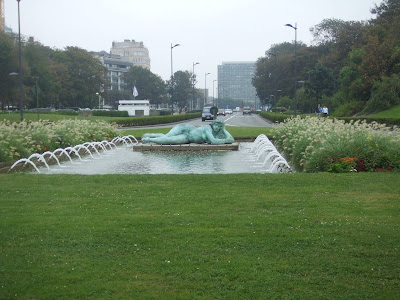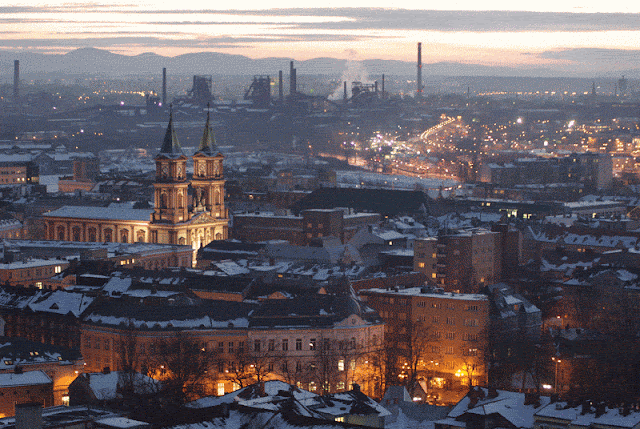Osijek is the fourth largest city in Croatia with a population of 128,095 in 2011. It is the largest city and the economic and cultural centre of the eastern Croatian region of Slavonia, as well as the administrative centre of Osijek-Baranja county. Osijek is located on the right bank of the river Drava, 25 kilometres (16 mi) upstream of its confluence with the Danube, at an elevation of 94 metres (308 ft).
The origins of human habitation of Osijek dates back to Neolithic times, with the first known inhabitants belonging to the Illyrian tribes. Roman emperor Hadrian raised the old settlement of Mursa to a colony with special privileges in 131. After that, Mursa had a turbulent history, with several decisive battles taking place (among which the Battle of Mursa Major in 351 and the battle between Aureolus and Ingenuus in 260), deciding the destiny of the whole region. After their migration, the Croats made a settlement near the ruins of Mursa, giving it its present name, Osijek. After the Hungarian settlements in Carpat basin, the population in Osijek was mostly Hungarian to the time of Ottoman occupation. The first mention of Osijek was in 1196 (forum Ezek et portas name). The ovner of the settlements market was the Abbey of Cikádor (now Bataszék in Hungary). Later mentioned in 1335 villa Ezeek, in 1352 possesio Ezek, in 1353 tributum fori in Ezeek et tributum portas fluvii Draue, 1454 opidium Ezek,1469 opidium Ezeek. The first mention of the fortress in 1472. (castellum Ezeek). Life was thriving here in the Middle Ages, but only traces of that life can be found today because of the destruction in Ottoman–Hungarian Wars as well as architectural changes during the Ottoman period.
The earliest mentions of Osijek date to 1196. The town was a feudal property of the Korogyi family between 1353 and 1472. After the death the last Korogyi, King Mathias granted it to the Rozgonyi family. But in 1493 it's owner was the Chapter of Holy Virgin in Buda (now Budapest). The city was damaged by the Ottoman conquerors on 8 August 1526. The Turks rebuilt it in oriental style and it was mentioned in the Turkish census of 1579. In 1566, Suleiman the Magnificent built a famous, 8 kilometer-long wooden bridge of boats in Osijek, considered to be one of the wonders of the world. The town was officially promoted to a city by the end of the 17th century.
Osijek was restored to western rule when on 29 September 1687 the Turks were kicked out and it became occupied by the Habsburg Empire. Between 1712 and 1721, new Austrian authorities built a new fortress (authored by the architect Maximilian de Gosseau), known as Tvrđa. It is a unique urban and military complex that lies in the heart of the town. Its main central Holy Trinity Square is closed on the north by the building of the Military Command, on the west there is the Main Guard building and on the east is the Magistrate building (presently Museum of Slavonia). In the middle of the square there is a monument to the plague, erected in 1729 by general Maximilian Petras' widow. The Gornji Grad (Upper Town) was founded in 1692 and Donji Grad (Lower Town) followed on 1698. Tvrđa, Gornji, and Donji grad continued as separate municipalities until 1786. In late 18th century it took over from Virovitica as the centre of the Verőce county.
During the 19th century, cultural life mostly revolved around the theatre, museums (the first museum, Museum of Slavonia was opened in 1877 by private donations), collections and printing houses (the Franciscans). City society, whose development was accompanied by a prosperous economy and developed trade relations, was related to religious festivals, public events (fairs), entertainment and sports. The Novi Grad (New Town) section of the city was built in the 19th century, as well as Retfala to the west.
The newest additions to the city include Sjenjak, Vijenac, Jug and Jug II, which were built in the 20th century. The city's geographical riverside location, and noted cultural and historical heritage — particularly the baroque Tvrđa, one of the most immediately recognizable structures in the region — facilitated the development of tourism. The Osijek oil refinery was a strategic bombing target of the Oil Campaign of World War II.
Immediately after the war, the daily newspaper Glas Slavonije has been relocated to Osijek and has printed there ever since. A history archive was established in the city in 1947 and city library in 1949. The Children's theatre and the art gallery were open in 1950.
Osijek has been connected with the Croatian republic's capital Zagreb and the previous federal capital Belgrade by a modern paved road since 1958. The new Drava bridge to the north was built in 1962.
During the war in Croatia, from 1991 to 1995, the city avoided heavy destruction (unlike nearby Vukovar, for example) and sustained moderate damage, especially to the centre and Co-cathedral of St. Peter and St. Paul and to the periphery. More than a thousand civilians also died in the daily shelling of the town. On the other hand, at least five Croatian officials were condemned for war crimes against Serb civilians in Osijek, including General Branimir Glavaš. While some buildings still have mild damage, most often the occasional superficial pockmark from artillery and mortar fire, the city's façades are generally in good shape, due to extensive restoration in recent times, preserving the charm of its intricate Austro-Hungarian Baroque architecture in the older quarters of town.
Osijek has been connected with the Croatian republic's capital Zagreb and the previous federal capital Belgrade by a modern paved road since 1958. The new Drava bridge to the north was built in 1962.
During the war in Croatia, from 1991 to 1995, the city avoided heavy destruction (unlike nearby Vukovar, for example) and sustained moderate damage, especially to the centre and Co-cathedral of St. Peter and St. Paul and to the periphery. More than a thousand civilians also died in the daily shelling of the town. On the other hand, at least five Croatian officials were condemned for war crimes against Serb civilians in Osijek, including General Branimir Glavaš. While some buildings still have mild damage, most often the occasional superficial pockmark from artillery and mortar fire, the city's façades are generally in good shape, due to extensive restoration in recent times, preserving the charm of its intricate Austro-Hungarian Baroque architecture in the older quarters of town.
Numerous events take place in the city throughout the year. The most important of them are the Croatian Tambura Music Festival (in May), attended by tambura orchestras from all over Croatia and the Osijek Summer Nights (during June, July and August), a series of cultural and entertainment programs in the open, accompanied by excellent food and fairs. The Day of the City of Osijek is celebrated with a cultural and artistic activities and exhibitions.
The surroundings of Osijek provide opportunities for hunting and angling on the Drava river and its backwaters. Hunting in the area known as Kopački Rit (in Baranja) is famous beyond the borders of Croatia.
The abundance of game and agriculture has made Osijek the country's semi-official gastronomical capital. Local dishes include traditional Slavonian-style specialities (kulen, paprika-flavoured sausage, other kinds of sausages, ham, bacon, dairy products), as well as venison and fish dishes such as the famous riblji paprikaš (fish stew made with paprika). Two brands of beer are brewed in Osijek: Osječko and Esseker. There is also the Baranja wine offered in restaurants.
The surroundings of Osijek provide opportunities for hunting and angling on the Drava river and its backwaters. Hunting in the area known as Kopački Rit (in Baranja) is famous beyond the borders of Croatia.
The abundance of game and agriculture has made Osijek the country's semi-official gastronomical capital. Local dishes include traditional Slavonian-style specialities (kulen, paprika-flavoured sausage, other kinds of sausages, ham, bacon, dairy products), as well as venison and fish dishes such as the famous riblji paprikaš (fish stew made with paprika). Two brands of beer are brewed in Osijek: Osječko and Esseker. There is also the Baranja wine offered in restaurants.
Osijek’s Top 5:
- The Church of St Peter and St Paul, the co-cathedral of the Roman Catholic Archdiocese of Đakovo-Osijek, is a neo-Gothic sacral structure. The multi-tiered 90-metre spire is one of the city's landmarks. The church was built in 1898 on the initiative of Đakovo-based Bishop Josip Juraj Strossmayer. The church is entered via a small door to the right of the main portal, overlooked by a trio of gargoyles. The interior is a treasure trove of neo-Gothic ornamentation, with a succession of pinnacled altars overlooked by exuberant stained glass windows. The interior was finished off in 1938–1942 when leading Croatian painter Mirko Rački covered the walls and ceilings with brightly coloured frescoes illustrating famous episodes from the Old and New Testaments.
- The bridge of youth (Most Mladosti) This pedestrian hanging bridge over the Drava river was built in 1979. Well designed and modern in stature, it has become one of the symbols of Osijek. You'll find it in most postcards and photos that reflect this lovely town. It's worth the look.
- Archeological Museum of Osijek. Osijek has been settled since the Stone Age, when waves of various Central European tribes ebbed and flowed across the plains. Celts, Romans, Croats, Avars, Goths, Hungarians, Austrians, Germans, Slovaks and Serbs have left their traces in the area. In 2007, artifacts from around the region found a new home, diagonally across the Holy Trinity Square from the Museum of Slavonija, in the renovated City Guardhouse and an adjacent house. The Archeological Museum Osijek opened in the fall with a small exhibit in the first three rooms and a display of larger Roman stone artifacts under a glass dome in a lovely arcaded courtyard. Especially interesting is a Celtic helmet that was probably tossed into the Sava during the 1st Century B.C. near Slavonski Brod and recovered during a period when the water level was low. Renovations were completed in March of 2009 and the permanent exhibition, which covers the period from the 5th to the 16th century in now open.
- Urania Cinema. The Urania was designed by Viktor Arman in 1912 and quickly became a much-discussed local landmark. Comprising a sensuous curvy roof and a vertical-striped façade, it looks like a huge church organ let loose on the city streets. A peach-colored paint-job (the result of recent renovations) only adds to the unsettling effect.
- Tvrđa (Citadel) is the Old Town of the city of Osijek in Croatia. It is the best-preserved and largest ensemble of Baroque buildings in Croatia and consists of a Habsburg star fort built on the right bank of the River Drava. Tvrđa has been described by the World Monuments Fund as "a unique example of an eighteenth-century baroque military, administrative, and commercial urban center". The star fort was constructed in the immediate vicinity of medieval Osijek after the defeat of the Ottoman forces in 1687, due to Osijek's strategic importance. The official construction began on August 1, 1712 and was supervised by the city and fort's commander, General Johann Stephen von Beckers. Constructed to plans by Mathias von Kaiserfeld and then Maximilian Gosseau de Henef it was inspired with the Lowlands (Dutch) fortress' of its time. All five planned bastions and two gates were complete by 1715. By 1735, the inner town was finished and three northern bastions had been added. When complete, it was the largest and most modern Habsburg fortress on the border of the Ottoman Empire.

References: http://www.inyourpocket.com/croatia/osijek









































